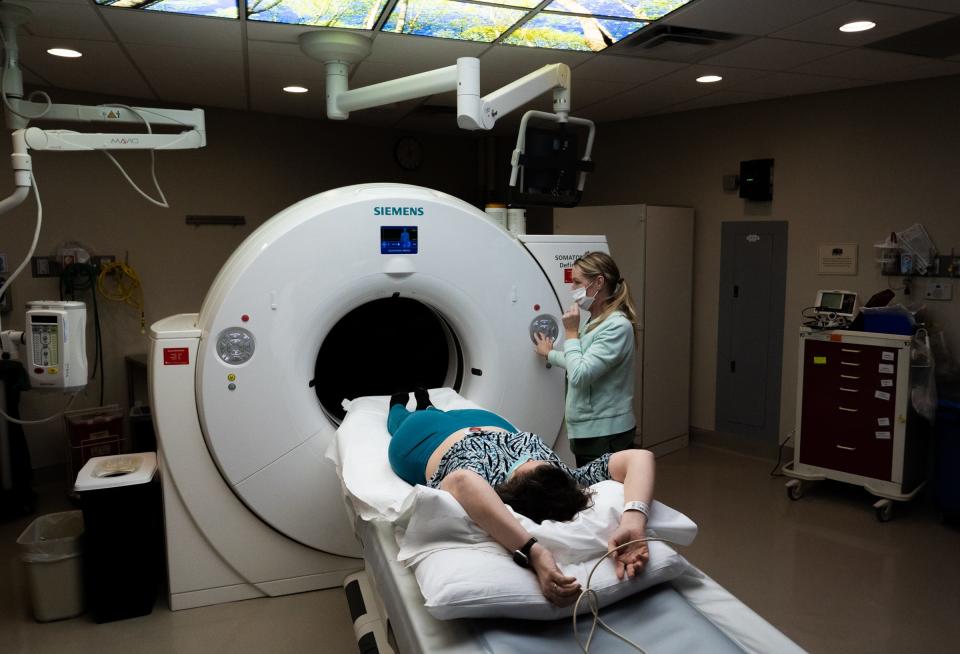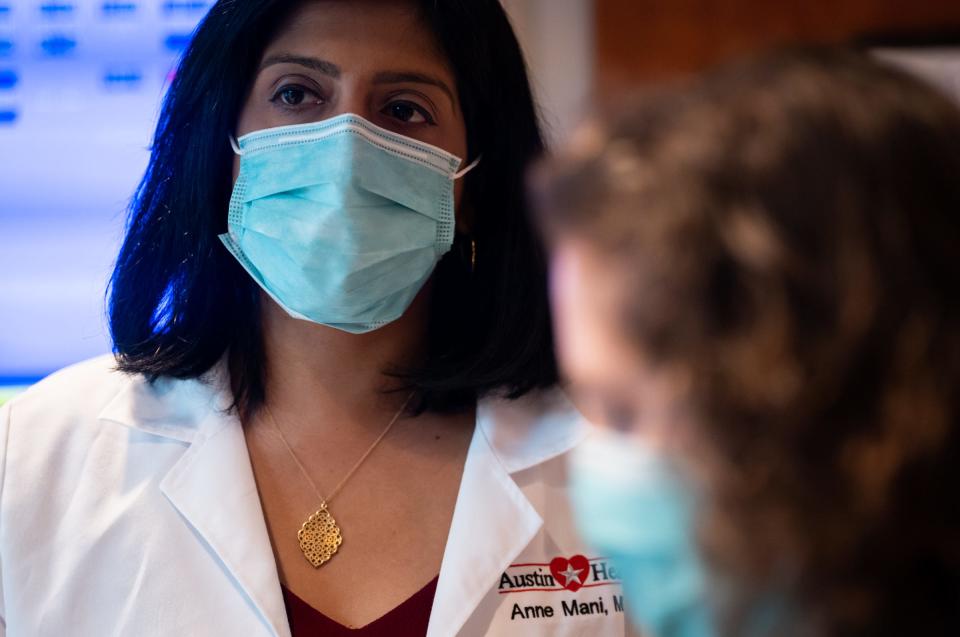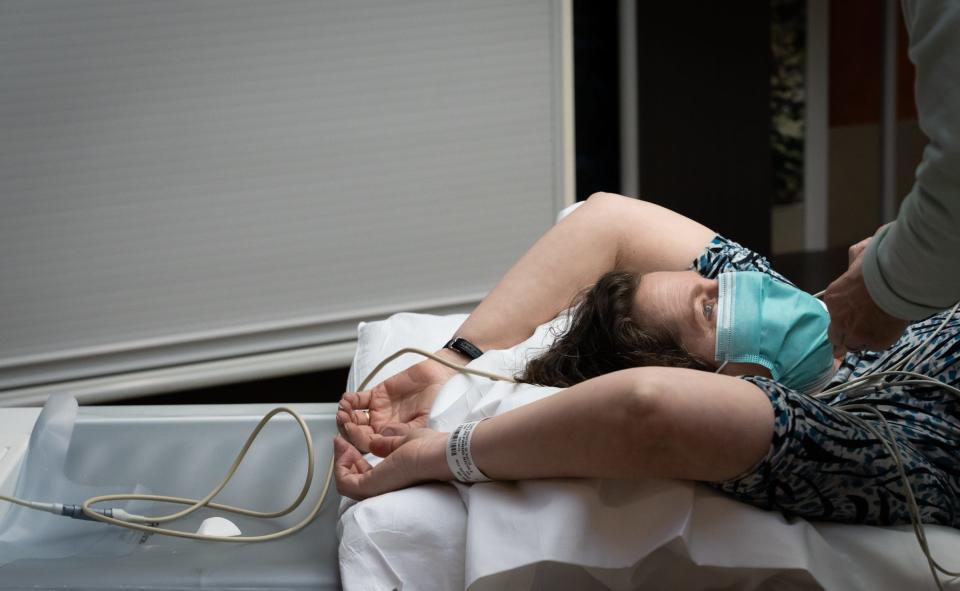Will I have a heart attack? CT scan looks at calcium in the arteries to assess your risk.
I lay on the bed of the CT scan at the Heart Hospital of Austin looking up at the ceiling as it moves into the CT tunnel. A voice through the speakers tells me to breathe in, hold my breath, then breathe out.
The bed of the CT scan moves back out of the tunnel. That's it. About 2 minutes of a CT scan. The technician and doctor can give me a score of how much calcium deposits they see inside the arteries of my heart.
That calcium is an indication of how much plaque has built up in the arteries. Plaque is a mixture of fat (cholesterol) and calcium, but only the calcium will show up on the CT scan.
Heart Hospital of Austin calls this screening a HeartSaver CT, but it's also known as a calcium score CT or coronary calcium scan.
"We all think we are healthy until something happens," said Dr. Anne Mani, a cardiologist at Austin Heart and Heart Hospital of Austin. "This is a good way to see what risks are there."
Heart care: 'Lucky to survive': St. David's helps prevent Austin man's heart attack story from being a tragedy

What do the results mean?
After the screening, Mani went over my report with me, which labeled each artery and gave a number to each as well as an overall percentile ranking.
The percentile score is based on a person's age, gender and the typical amount of calcium in the arteries for that age and gender. If I had a score that was above 50%, that would mean that I had more calcium that most women my age. If my score was below 50%, that would mean I had less calcium than most people. Mine was between 0% and 50%, which means that I had less calcium in my arteries than most women my age.
Then it gave a score to each artery. Mine were all 0. 0 means there was no identifiable plaque, which means I have a low cardiovascular risk.
If I had gotten between 11 and 100 in an artery, that would mean I had mild plaque and likely mild or minimal coronary stenosis — hardening of the arteries. A score of 101 to 400 means moderate plaque, with moderate nonobstructive coronary artery disease likely. Above 400 means there is extensive plaque and a high likelihood of at least one significant coronary narrowing.
Expanding heart care: Austin becomes global draw for doctors learning about heart arrhythmia
How do the results translate to real life?
If I had an elevated score, my primary care doctor or cardiologist would work with me on lowering my risk factors. That includes making sure my blood pressure is under control, my cholesterol, especially my LDL (the bad kind) is as low as possible.
Making those medication and lifestyle adjustments wouldn't mean that I could get rid of the plaque. Once it's there, it's there; but I can prevent further plaque buildup.
A low percentile of calcium doesn't mean that I won't have a heart attack in the future, it just means that the chances of it are currently low.
It also doesn't translate to heart valve problems or arrhythmia or heart failure or other things that can go wrong with the heart.
Expanding care: 'Patients fly all over the world for him': Dell Medical School appoints leader for new heart surgery program

Who can get a HeartSaver CT scan?
HeartSaver CT scans are for men between ages 40 and 65 and women between ages 40 and 70.
It's recommended if you have a family history of heart disease or another risk factor such as high cholesterol, obesity, high blood pressure, diabetes sleep apnea, inactive lifestyle, smoking or erectile dysfunction.
It is not for people younger than 40 because it takes a while for plaque to build up.
People who already have had a heart attack or stroke do not need a HeartSaver CT because their risk factors for a second heart attack and stroke are already known to be high.

How often do you need one?
Based on your score, the cardiologist might recommend another one in five to 10 years, or might recommend another one sooner, or might move on to more serious interventions, rather than scanning again.
Why isn't the HeartSaver CT scan covered by insurance?
For insurance to pay, insurers require there to be a quantifiable benefit to this screening, Mani said. Some studies have been done, but "we don't have enough data now," Mani said. This is about being able to predict the future, a decade-plus away. More studies over a long length of time will have to be done to prove its predictability.
Improving heart health: Put down the coconut oil, red wine in new heart health dietary guidelines
Where can I go to get scanned?
You can make an appointment at Heart Hospital of Austin by calling 512-407-SAVE.
Ascension Seton hospitals call it a Heart Healthy CT, and you can schedule online at healthcare.ascension.org/specialty-care/cardiology/why-ascension/txaus-austin-tx-heart-care.
ARA Diagnostic Imaging also does them. You can schedule at 512-887-7474.
This article originally appeared on Austin American-Statesman: Will I have a heart attack? Calcium CT scan looks at heart attack risk
